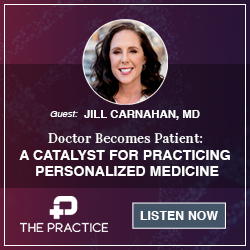
by Bianca Garilli, ND
The 2018 National Physician Burnout & Depression Report published by Medscape surveyed more than 15,000 physicians from 29 specialties on a wide array of topics, one of which was physician burnout.1 The topic of physician burnout has become increasingly important in medicine due to its impact on both the provider’s health and wellbeing, as well as its potential negative impact on patients’ safety and quality of care.1 Physician burnout can be described as a “work-related syndrome involving emotional exhaustion, depersonalization, and a sense of reduced personal accomplishment.”2
Responses from the National Physician Burnout & Depression Report indicate that 42% of physicians experience burnout, with female physicians noting higher burnout rates (48%) than their male counterparts (38%).1 The highest burnout rates (50%) were found in the middle-aged physicians (45-54 years), with lower burnout rates in the younger (28-34 years) and older physicians (55-69 years), 35% and 41%, respectively.1 Overall, lower rates of burnout were noted in non-emergent specialty areas such as plastic surgery (23%), dermatology and pathology (both 32%), and ophthalmology (33%) as compared to front-line practitioners working in specialties such as critical care and neurology (both 48%), family medicine (47%), and OB-GYN (46%).1
Consequences of physician burnout are far-reaching. Depression is commonly experienced concomitantly with burnout, with 14% of all physicians estimated to experience both conditions.1 In addition to potential adverse effects on patient outcomes and the physician’s health, burnout may also impact workforce moral, healthcare costs, and functionality of healthcare organizations and systems including increasing turnover rates, lowering job satisfaction and organizational commitment, and worsening job performance.2-3
Some of the most common and influential causes of practitioner burnout include:2,4
- High job demands and excessive workloads
- Lack of control over workload and schedules
- Inefficient work processes
- Administrative burden
- Conflicting work-home balance
- Conflicting values in the practice of medicine
- Breakdown of community within the profession
- Lack of input with respect to organizational support structures and leadership culture
A study published in the Journal of the American Board of Family Medicine took a deeper look into the prevalence and correlates of physician burnout.5 This particular cross-sectional analysis collected data from 235 medical providers practicing in 174 small independent primary (SIP) care practices in New York City.5 The purpose of the study was to determine if practitioner burnout varied between those providers working in SIPs (<5 providers) vs. providers employed in hospitals or large primary care practices (settings in which the bulk of previous physician burnout research has been conducted).5 The majority (66.9%) of SIPs reviewed in this study were solo provider practices, and 46.5% were patient-centered medical home (PCMH) recognized; 204 of the providers were MDs, and 31 were NPs or PAs.5
Findings from this study indicate the rate of provider-reported burnout in SIPs was 13.5%, which is significantly lower than the national average reported for all physicians in 2011 (45.5%) and 2014 (54.4%).5 Additionally, a higher adaptive reserve score was associated with lower odds of burnout; for the purposes of this study, the authors defined adaptive reserve as the ability to transform a practice with greater “internal capacity for organizational learning and development”.5 The study concluded that working in a SIP may reduce the risk of practitioner burnout for several reasons, including:5
- Higher autonomy and greater sense of control over work environment
- Opportunities for creating deeper relationships with patients
- Higher job satisfaction
- Improved work-life balance
- Capacity for work environment changes/transformations to take place
What are the takeaways?
- SIPs show lower levels of practitioner burnout when compared to larger organizations and hospital settings5
- Practitioner burnout is a major concern in healthcare that can be found across all specialties, with emergency and front-line practitioners reporting the highest burnout rates1
- Depression is often associated with practitioner burnout1
- Practitioner burnout impacts health of the practitioner, patient quality of care, healthcare organization and structure, cost of healthcare, and various other important medical outcomes1-4
- Improving work-life balance, sense of autonomy, and control over one’s schedule and workload, as well as increasing adaptive reserve, can lower risk of practitioner burnout5
Citations
- Medscape. Medscape National Physician Burnout & Depression Report 2018. https://www.medscape.com/slideshow/2018-lifestyle-burnout-depression-6009235. Accessed August 16, 2018.
- West CP et al. Physician burnout: contributors, consequences and solutions. J Intern Med. 2018;283(6):516-529.
- Azam K et al. Causes and adverse impact of physician burnout: a systematic review. J Coll Physicians Surg Pak. 2017;27(8):495-501.
- Collier R. Physician burnout a major concern. CMAJ. 2017;189(39):E1236–E1237.
- Blechter B et al. Correlates of burnout in small independent primary care practices in an urban setting. J Am Board Fam Med. 2018;31(4):529-536.
Bianca Garilli, ND, IFMCP is a former US Marine turned Naturopathic Doctor (ND). Dr. Garilli works in private practice in Northern California as well as running a consulting company working with leaders in the natural and functional medicine world such as the Institute for Functional Medicine and Metagenics. She is passionate about optimizing health and wellness in individuals, families, companies and communities- one lifestyle change at a time. Dr. Garilli has been on staff at the University of California Irvine, Susan Samueli Center for Integrative Medicine and is faculty at Hawthorn University. She is the creator of the Veterans for Health Initiative and is the current Past-President of the Children’s Heart Foundation, CA Chapter.






